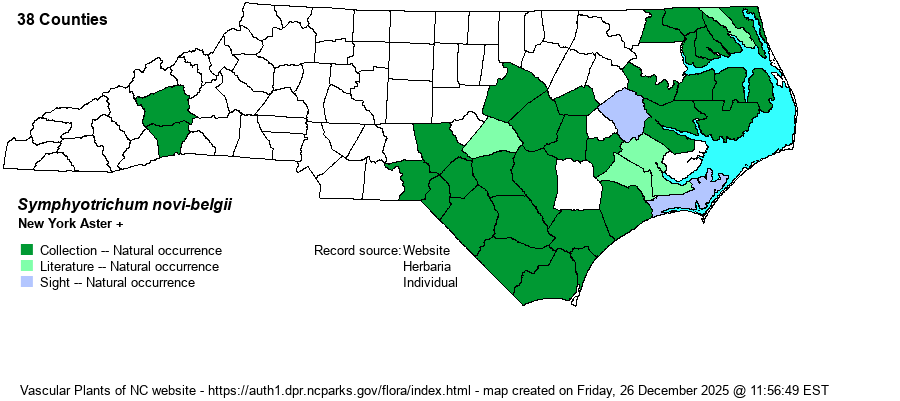| Author | (L.) Nesom | |
| Distribution | Coastal Plain and Sandhills, including the northern Outer Banks. Disjunct to the Mountains in Buncombe County (moist soil near Biltmore in 1897, 1909) and Henderson County (East Flat Rock in 1898, 1935; McClure's Bog in 2018). Apparently only var. elodes occurs in NC and it displays considerable variation.
Coastal Plain, N.B. to SC. | |
| Abundance | Infrequent to fairly common in its Coastal Plain/Sandhills range, but can be local; most numerous in the northeastern counties around Albemarle Sound, where locally common. Very rare in the Mountains. | |
| Habitat | Moist to wet soils of brackish marshes, fresh-tidal marshes, roadside ditches, cypress-gum swamps and openings, blackwater streamheads, impoundment shores, beaver ponds; montane bogs. | |
| Phenology | Flowering and fruiting late September-November. | |
| Identification | The variety of New York Aster found in NC typically grows 1-3 feet tall, stem and leaves glabrous, leaves linear or linear-lanceolate, mostly tapering to the base if not slightly clasping, and essentially untoothed. The inflorescence is elongate -- usually wider than tall -- with heads on long to short stalks from leaf axils. Heads are large, with long, lavender or lavender-blue rays. This species has a characteristic sprawling, bushy look, hardly looking erect; as it has numerous light bluish rays on the flowers, it is hard to overlook when in bloom. | |
| Taxonomic Comments | NOTE: The genus Aster was examined by G.L. Nesom (1994), who determined that it was composed of a number of discrete genera (a few of which were already split off by authors as Sericocarpus, Ionactis, etc.). The earliest available name for North American "Aster" is Symphyotrichum, a name regrettably long and hard to spell.
No other variety of New York Aster occurs in NC.
| |
| Other Common Name(s) | None | |
| State Rank | S4? [S4] | |
| Global Rank | G5 | |
| State Status | | |
| US Status | | |
| USACE-agcp | OBL link |
| USACE-emp | FACW link |

